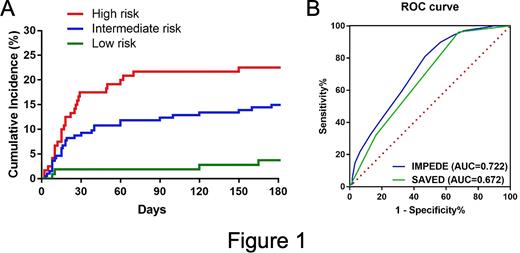Abstract
Background: The risk of venous thromboembolism (VTE) was 9-fold increase in multiple myeloma (MM) compared to the general population. In addition, the mortality rate of MM patients with VTE is three times higher compared to patients without VTE, which makes it so important to identify those at high risk and commit to preventing VTE events. Recently, the IMPEDE VTE score has emerged as a novel risk prediction tool for VTE in MM and has been incorporated and adopted by the NCCN guidelines. The variation in IMPEDE VTE scores is greatly influenced by Asian ethnicity/race, however, it lacks validation, especially for the Chinese populations. Furthermore, the validation of the IMPEDE VTE score's predictive ability for VTE in Caucasian and Black MM is controversial (Blood (2021) 138 (Supplement 1): 2971; Br J Haematol. 2021 Jun;193(6):1213-1219). Therefore, our objective was to validate the predictive ability of the IMPEDE VTE score for VTE in Chinese patients with MM.
Methods: We performed a retrospective chart review of all patients with newly diagnosed MM who started chemotherapy at Beijing Jishuitan Hospital between 2011 and 2021 with a minimum of 6 months follow-up. Patients with coexisting tumors, missing data used to calculate VTE scores were excluded. In addition, The SAVED score, simultaneously adopted by the current NCCN Guidelines in risk-stratification of patients with MM receiving IMiD therapy, were analyzed and compared. The scores for IMPEDE VTE and SAVED were calculated from the date of chemotherapy initiation. Statistical analysis included Chi-square, Fisher's test, Wilcoxon rank sum tests, COX hazard, log-rank and K-M survival analysis. A p-value ≤ 0.05 was considered significant and all analysis was completed in SPSS 23.0 and Graphpad Prism version 8.0.
Results: Our cohort included 423 newly diagnosed MM patients, 100% Chinese, 221 of whom were male (52.2%) and 141 (33.3%) patients were older than 65 years. Median age and BMI at diagnosis were 60.8 (IQR: 54.0-68.0) years and 24.5 (IQR: 22.2-26.6) kg/m2, respectively. Kaplan Meier survival analysis showed a 5-year survival rate of 53.72%. In the entire cohort, 62 (17.17%) patients developed VTE and 361 patients did not experience VTE within 6 months of treatment onset. The IMPEDE VTE scores at the start of treatment were ≤3 (low risk), 4-7 (moderate risk) and ≥8 (high risk) in 171 (40.43%), 209 (49.41%) and 43 (10.17%) patients, respectively. The median IMPEDE VTE score was 4 (IQR: 2-5) in all patients and 6 (IQR: 4-9) vs. 4 (IQR: 2-5) in the VTE vs. no VTE cohort, respectively (P < 0.001). Patients with MM in the VTE cohort were more likely to have a history of previous VTE (32.3% vs. 3.9%, P < 0.001), paraplegia (9.7% vs. 2.8%, P = 0.011), and extramedullary plasmacytoma (14.5% vs. 4.7%, P = 0.001) compared with no VTE cohort. Within 6 months of treatment initiation, central venous catheter was more frequently used in the VTE cohort as compared to the no VTE cohort (53.2% vs. 20.8%, P < 0.001). The 6-month cumulative incidence of VTE among all patients was 14.7% (95% CI: 11.3%-18%). In univariate Cox hazard analysis, each 1-point increase in IMPEDE VTE score was associated with the occurrence of VTE within 6 months of treatment initiation (HR: 1.33, 95% CI: 1.23-1.44, P < 0.001). According to the IMPEDE VTE score, the 6-month cumulative incidence of VTE was 3.7% (95% CI: 0.1-7.3) , 14.9% (95% CI: 9.9%-20%) and 24.0% (95% CI: 16.3-31.7) in the low-, intermediate- and high-risk groups (P < 0.001, log-rank), respectively (Fig 1A). The c-statistic of the IMPEDE VTE and SAVED scores for predicting VTE within 6 months of treatment initiation was 0.722 (95% CI: 0.647-0.796) and 0.672(95% CI:0.593-0.752), respectively (Fig 1B). The median follow-up of patients was 27.8 months (IQR: 12.1-49.2). On multivariable Cox hazard analysis, VTE within 6 months of treatment initiation was not a predictor of PFS (HR: 0.854, 95% CI: 0.576-1.267, P = 0.434) and OS (HR: 0.853, 95% CI: 0.527-1.379, P = 0.516) after adjusted for age, prognostic stage, cytogenetics, and ASCT.
Conclusions: Our findings suggest that the IMPEDE VTE score is a valid evidence-based risk stratification tool in Chinese patients with newly diagnosed MM. Both the IMPEDE VTE (P=0.722) and SAVED (P=0.672) scores could statistically predict VTE outcomes in our patient population, and the IMPEDE VTE score outperformed the SAVED score in risk-stratification of Chinese patients with MM treated with IMiD.
Disclosures
No relevant conflicts of interest to declare.
Author notes
Asterisk with author names denotes non-ASH members.


This feature is available to Subscribers Only
Sign In or Create an Account Close Modal